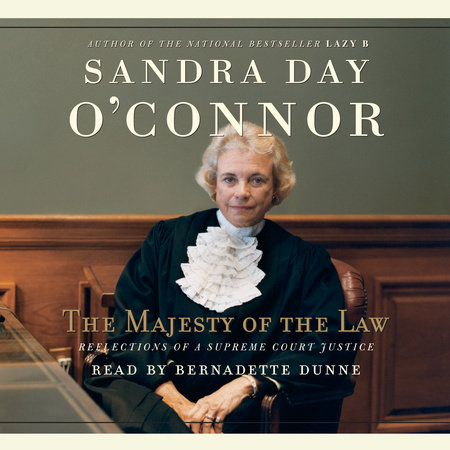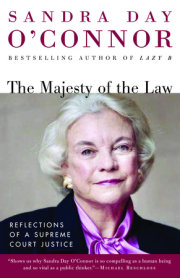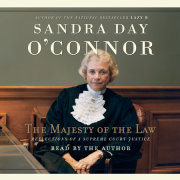CHAPTER ONEWhat's It Like?What is it like working at the supreme court?
Because I never dreamed that I would end up where I am, I had no preconceived ideas about the job upon arriving for work the first day. I had not been admitted to practice before the Court. The first argument I ever witnessed in the Supreme Court was one that I considered as a member of the Court justice. My guess is that such experiences were not uncommon for new Justices, at least until more recent years.
All I knew was that the job would be a tremendous undertaking. I had no specific ideas about the mechanics of being a Justice, however, or what the decision-making process on the Court was really like. I hoped that I had the basic ability and could develop the skills not only to do the job but to do it well in order that not only women but most citizens would think that the President had made a good choice.
There is one custom we have on the Court that was a pleasant surprise to me and that I treasure. Each day when there is oral argument, just before we go out on the bench, and each day before we confer, every Justice shakes the hand of every other Justice. To an outsider, this may seem baroque and unnecessary, but you must realize we are a very small group. We see and interact with one another often, and we all know we will continue to do so for the rest of our professional lives. It is important that we get along together so we can go along together.
The one-page memo and the color-coded distribution sheet have yet to reach the Supreme Court. Indeed, the Court is a more reliable backstop for the health of the paper industry than any protectionist legislation Congress might pass. A Justice is by protocol allowed to make a grocery list without making eight copies to distribute around the Court, but pretty much everything else is done not only on paper but with copies for every other Justice to read as well.
Petitions asking the Court to grant review of a case come to us throughout the year from both the federal and the state court systems. And they come in significant numbers. We now receive more than seven thousand applications a year. Many call but few are chosen; the Court accepts for full review with briefing and oral argument no more than one hundred or so cases for each year's term. In addition, the Court summarily decides up to another hundred or so cases without oral argument and full briefing. In making this drastic culling, the Court has relatively few hard and fast rules to guide or restrict its decisions.
We follow an unwritten policy that it takes the agreement of at least four Justices to accept a case. With each petition we consider the importance of the issue, how likely it is to recur in various courts around the country, and the extent to which other courts considering the issue have reached conflicting holdings on it.
My own evaluation of the applications is based on what I believe to be the primary role of the Court: with fifty separate state-court systems and thirteen federal circuits, our task is to try to develop a reasonably uniform and consistent body of federal law. Petitions seeking full-scale review in cases posing a genuine conflict among the lower courts on an important issue of federal law obviously are much more likely to garner the required number of votes to grant the petition than are petitions in cases where the lower courts are generally in agreement on the legal issue in the case.
Each year the members of the Court must read the briefs in the one hundred or so cases on which the Court hears oral arguments. After argument, each case has to be decided and explained in a published opinion.
During the weeks of oral arguments The Justices confer after the arguments are heard. This is where we learn how each Justice thinks the case should be resolved and why. Based on this discussion, writing assignments are made for the case. If the Chief Justice is in the majority on a case, he assigns the writing of the Court's opinion to one of the Justices in the majority or to himself. If not, the most senior justice in the majority makes the assignment. Likewise, if a dissent is to be written and joined by more than one Justice, the most senior Justice planning to join that dissent assigns the writing.
The writer of the majority opinion must try to reconcile the views of those in the majority. When the opinion draft is circulated, each Justice reads it and decides whether to join it or to ask for revisions as a condition of joining. Sometimes a Justice will write a concurring opinion subscribing to the result in the majority opinion but based on different reasons, which it provides. If there is a dissenting view, that too is written up and circulated to all the Justices. In the end the opinion for the Court may be the result of many drafts and changes. Eventually, each participating Justice will have agreed to one or more of the opinions in the case. Each term produces something like five thousand pages' worth of opinions in the United States Reports. It all adds up to a lot of paper.
Serving on the Court has provided me with a number of pleasant surprises. Some people think that the Court is full of bitter battles, and it is true that the Court's opinions sometimes include strong language. But in fact one of my earliest and most rewarding experiences on the Court, and one that I did not fully anticipate, was of the warmth, kindness, and civility of my fellow Justices. Every one of my colleagues has been very thoughtful and considerate. There have been times with some previous Courts when some members did not get along and when some animosity persisted among certain Justices. Happily, that has not been the situation during my time here. It is a particular pleasure to be able to serve in an atmosphere of respect and affection for one's colleagues.
What is quite remarkable in my view is that each and every petition for review, whether produced by a sophisticated lawyer in a high-rise or handwritten by a prison inmate or a private citizen in her home, is reviewed with care by each Justice. And every written opinion of the Court is read with utmost care and attention by every other Justice, with an eye toward refinement or improvement. The process we follow, I think, provides some reason to have faith in the nation's judicial system.
Of course, not everyone is happy with the Court's decision in any given case. After all, you have two sides only one can win. And often that unhappy party is the court below, because the Supreme Court reverses about two thirds of the lower-court decisions in those cases it reviews.
When I am not hearing oral arguments, researching and considering the law, or discussing the cases with my colleagues or my clerks, part of my time is spent dealing with a mass of correspondence. Some relates to pending cases. I ignore all such letters. Many letters are from schoolchildren who want information from me or about me. I do the best I can to process and answer these.
People often think of the Supreme Court as a remote Washington institution. State and local judges are forced by proximity to stay in touch with the concerns of those they serve. The Supreme Court, in contrast, serves a national purpose for a vast country. One might wonder, therefore, if the Court is simply a large, federal institution, distant and out of touch with the people. But in fact the Court is not a bad place from which to get some sense of the nation's concerns, or at least its national legal concerns. The more than seven thousand petitions for review each year come from all across the country and involve a very wide range of legal issues. The Court hears oral argument in cases that have their genesis in front-page actions by Congress as well as in the actions of police officers in tiny towns. The attorneys who appear before the Court, and the clients whose problems have brought them there, present a similarly broad geographical cross section.
Justices are drawn from all over the country and are a diverse group. This, in my view, is another reason to be optimistic about the Court. Diversity is its strength, just as it is the strength of America itself. In my twenty plus years on the Court, I have learned at least one lesson very vividly. A Justice is constantly called upon to try to draw some harmony from that diversity-and even to reconcile the irreconcilable.
E. B. White said, "Democracy is based on the recurrent suspicion that more than half of the people are right more than half of the time."1 In the narrow view, the Supreme Court is based on the suspicion that five Justices are similarly correct. In the broader view, I think that the Justices contribute to the wider democracy. We struggle with national issues and attempt to define from a national perspective what it is that the federal laws and the Constitution say. If you don't agree with all of the Court's holdings, you are certainly not alone. But you may be confident that we never stop trying in our writings on every case on our agenda to contribute appropriately to the fragile balances of our national democracy.
Copyright © 2003 by Sandra Day O'Connor. All rights reserved. No part of this excerpt may be reproduced or reprinted without permission in writing from the publisher.











